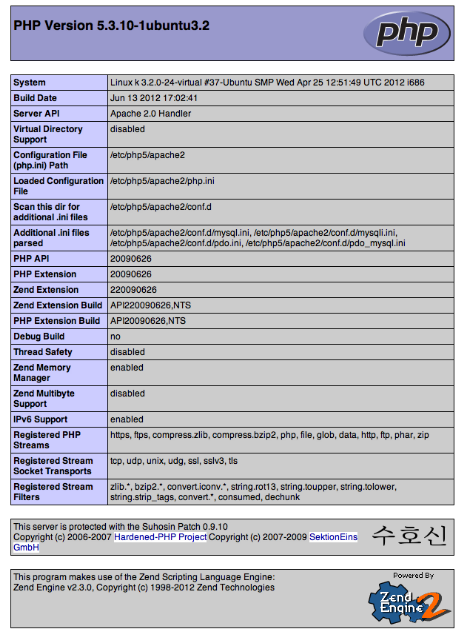How To Install Linux, Apache, MySQL, PHP (LAMP) stack on Ubuntu
About LAMP
LAMP stack is a group of open source software which is required to get a site or an application up and running. The acronym stands for Linux, Apache, MySQL, and PHP.
Your virtual private server already comes with Ubuntu and you will need to install the remaining software.
- automatically, by ssuing the following command:
tasksel install lamp-server
- manually by following the procedure which is explained below.
Set Up
In order to be able to follow the steps in this tutorial you need root priviliges on your VPS. In addition, it is recommended that you update your OS by issuing the following command:
sudo apt-get update
Step 1: Install Apache
In order to install apache, open the terminal and type in these commands:
sudo apt-get update sudo apt-get install apache2
How to Find your Server’s IP address
In order to show your server's IP address, type the following command:
ifconfig eth0 | grep inet | awk '{ print $2 }'
Step 2: Install MySQL
In order to install MySQL, open the terminal and type in these commands
sudo apt-get install mysql-server libapache2-mod-auth-mysql php5-mysql
During the installation, MySQL will ask you to set a root password, but you can also set it afterwards using the MySQL shell.
After the installation is completed, you will need to activate MySQL using the following command:
sudo mysql_install_db
Then, run the script for setting up MySQL:
sudo /usr/bin/mysql_secure_installation
The prompt will ask you for your current root password.
Type it in.
Enter current password for root (enter for none): OK, successfully used password, moving on...
Then the prompt will ask you if you want to change the root password. Choose N and move on to the next steps.
For the rest of the options you can respond with "Yes". At the end, MySQL will reload and implement the new changes.
By default, a MySQL installation has an anonymous user, allowing anyone to log into MySQL without having to have a user account created for them. This is intended only for testing, and to make the installation go a bit smoother. You should remove them before moving into a production environment. Remove anonymous users? [Y/n] y ... Success! Normally, root should only be allowed to connect from 'localhost'. This ensures that someone cannot guess at the root password from the network. Disallow root login remotely? [Y/n] y ... Success! By default, MySQL comes with a database named 'test' that anyone can access. This is also intended only for testing, and should be removed before moving into a production environment. Remove test database and access to it? [Y/n] y - Dropping test database... ... Success! - Removing privileges on test database... ... Success! Reloading the privilege tables will ensure that all changes made so far will take effect immediately. Reload privilege tables now? [Y/n] y ... Success! Cleaning up...
Once you're done with that you can finish up by installing PHP.
Step 3: Install PHP
PHP is an open source web scripting language that is widely use to build dynamic webpages.
To install PHP, open terminal and type in this command.
sudo apt-get install php5 libapache2-mod-php5 php5-mcrypt
After you answer yes to the prompt twice, PHP will install itself.
It may also be useful to add php to the directory index, to serve the relevant php index files:
sudo nano /etc/apache2/mods-enabled/dir.conf
Add index.php to the beginning of index files. The page should now look like this:
DirectoryIndex index.php index.html index.cgi index.pl index.php index.xhtml index.htm
PHP Modules
PHP also has a variety of useful libraries and modules that you can add onto your virtual server. You can see the libraries that are available.
apt-cache search php5-
Terminal will then display the list of possible modules. The beginning looks like this:
php5-cgi - server-side, HTML-embedded scripting language (CGI binary) php5-cli - command-line interpreter for the php5 scripting language php5-common - Common files for packages built from the php5 source php5-curl - CURL module for php5 php5-dbg - Debug symbols for PHP5 php5-dev - Files for PHP5 module development php5-gd - GD module for php5 php5-gmp - GMP module for php5 php5-ldap - LDAP module for php5 php5-mysql - MySQL module for php5 php5-odbc - ODBC module for php5 php5-pgsql - PostgreSQL module for php5 php5-pspell - pspell module for php5 php5-recode - recode module for php5 php5-snmp - SNMP module for php5 php5-sqlite - SQLite module for php5 php5-tidy - tidy module for php5 php5-xmlrpc - XML-RPC module for php5 php5-xsl - XSL module for php5 php5-adodb - Extension optimising the ADOdb database abstraction library php5-auth-pam - A PHP5 extension for PAM authentication [...]
Once you decide to install the module, type:
sudo apt-get install name of the module
You can install multiple libraries at once by separating the name of each module with a space.
Congratulations! You now have LAMP stack on your droplet!
Step 4: RESULTS — See PHP on your Server
Although LAMP is installed, we can still take a look and see the components online by creating a quick php info page
To set this up, first create a new file:
sudo nano /var/www/info.php
Add in the following line:
Then Save and Exit.
Restart apache so that all of the changes take effect:
sudo service apache2 restart
Finish up by visiting your php info page (make sure you replace the example ip address with your correct one): http://12.34.56.789/info.php
It should look similar to the screenshot below.
